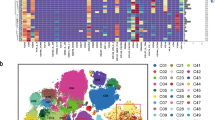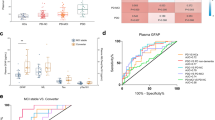Abstract
The identification of biological markers of Alzheimer's disease (AD) can be extremely useful to improve diagnostic accuracy and/or to monitor the efficacy of putative therapies. In this regard, peripheral cells may be of great importance, because of their easy accessibility. After subjects were grouped according to diagnosis, the expression of conformationally mutant p53 in blood cells was compared by immunoprecipitation or by a cytofluorimetric assay. In total, 104 patients with AD, 92 age-matched controls, 15 patients with Parkinson's disease and 9 with other types of dementia were analyzed. Two independent methods to evaluate the differential expression of a conformational mutant p53 were developed. Mononuclear cells were analyzed by immunoprecipitation or by flow-cytometric analysis, following incubation with a conformation-specific p53 antibody, which discriminates unfolded p53 tertiary structure. Mononuclear cells from AD patients express a higher amount of mutant-like p53 compared to non-AD subjects, thus supporting the study of conformational mutant p53 as a new putative marker to discriminate AD from non-AD patients. We also observed a strong positive correlation between the expression of p53 and the age of patients. The expression of p53 was independent from the length of illness and from the Mini Mental State Examination value.
This is a preview of subscription content, access via your institution
Access options
Subscribe to this journal
Receive 12 print issues and online access
$259.00 per year
only $21.58 per issue
Buy this article
- Purchase on Springer Link
- Instant access to full article PDF
Prices may be subject to local taxes which are calculated during checkout





Similar content being viewed by others
References
Turner RS . Biomarkers of Alzheimer's disease and mild cognitive impairment: are we there yet? Exp Neurol 2003; 183: 7–10.
Govoni S, Gasparini L, Racchi M, Trabucchi M . Peripheral cells as an investigational tool for Alzheimer's disease. Life Sci 1996; 59: 461–468.
Blennow K . Cerebrospinal fluid protein biomarkers for Alzheimer's disease. NeuroRx 2004; 1: 213–225.
Blennow K . CSF biomarkers for Alzheimer's disease: use in early diagnosis and evaluation of drug treatment. Expert Rev Mol Diagn 2005; 5: 661–672.
Wallin AK, Blennow K, Andreasen N, Minthon L . CSF biomarkers for Alzheimer's disease: levels of beta-amyloid, tau, phosphorylated tau relate to clinical symptoms and survival. Dement Geriatr Cogn Disord 2006; 21: 131–138.
Uberti D, Carsana T, Bernardi E, Rodella L, Grigolato P, Lanni C et al. Selective impairment of p53-mediated cell death in fibroblasts from sporadic Alzheimer's disease patients. J Cell Sci 2002; 115(Pt 15): 3131–3138.
Uberti D, Lanni C, Carsana T, Francisconi S, Missale C, Racchi M et al. Identification of a mutant-like conformation of p53 in fibroblasts from sporadic Alzheimer's disease patients. Neurobiol Aging 2006; 27: 1193–1201.
Ko LJ, Prives C . p53: puzzle and paradigm. Genes Dev 1996; 10: 1054–1072.
Levine AJ . p53, the cellular gatekeeper for growth and division. Cell 1997; 88: 323–331.
Giaccia AJ, Kastan MB . The complexity of p53 modulation: emerging patterns from divergent signals. Genes Dev 1998; 12: 2973–2983.
Uberti D, Belloni M, Grilli M, Spano P, Memo M . Induction of tumour-suppressor phosphoprotein p53 in the apoptosis of cultured rat cerebellar neurones triggered by excitatory amino acids. Eur J Neurosci 1998; 10: 246–254.
McGahan L, Hakim AM, Robertson GS . Hippocampal Myc and p53 expression following transient global ischemia. Brain Res Mol Brain Res 1998; 56: 133–145.
Culmsee C, Zhu X, Yu QS, Chan SL, Camandola S, Guo Z et al. A synthetic inhibitor of p53 protects neurons against death induced by ischemic and excitotoxic insults, and amyloid beta-peptide. J Neurochem 2001; 77: 220–228.
Gilman CP, Chan SL, Guo Z, Zhu X, Greig N, Mattson MP . p53 is present in synapses where it mediates mitochondrial dysfunction and synaptic degeneration in response to DNA damage, and oxidative and excitotoxic insults. Neuromol Med 2003; 3: 159–172.
Morrison RS, Kinoshita Y, Johnson MD, Guo W, Garden GA . p53-dependent cell death signaling in neurons. Neurochem Res 2003; 28: 15–27.
Miller G, Robinson J, Heston L, Lipman M . Differences between laboratory strains of Epstein–Barr virus based on immortalization, abortive infection, and interference. Proc Natl Acad Sci USA 1974; 71: 4006–4010.
McKhann G, Drachman D, Folstein M, Katzman R, Price D, Stadlan EM . Clinical diagnosis of Alzheimer's disease: report of the NINCDS-ADRDA Work Group under the auspices of Department of Health and Human Services Task Force on Alzheimer's Disease. Neurology 1984; 34: 939–944.
Hughes AJ, Daniel SE, Kilford L, Lees AJ . Accuracy of clinical diagnosis of idiopathic Parkinson's disease: a clinico-pathological study of 100 cases. J Neurol Neurosurg Psychiatry 1992; 55: 181–184.
Hoehn MM, Yahr MD . Parkinsonism: onset, progression and mortality. Neurology 1967; 17: 427–442.
Hixson JE, Vernier DT . Restriction isotyping of human apolipoprotein E by gene amplification and cleavage with HhaI. J Lipid Res 1990; 31: 545–548.
Di Luca M, Pastorino L, Cattabeni F, Zanardi R, Scarone S, Racagni G et al. Abnormal pattern of platelet APP isoforms in Alzheimer disease and Down syndrome. Arch Neurol 1996; 53: 1162–1166.
Rosenberg RN, Baskin F, Fosmire JA, Risser R, Adams P, Svetlik D et al. Altered amyloid protein processing in platelets of patients with Alzheimer disease. Arch Neurol 1997; 54: 139–144.
Tang K, Hynan LS, Baskin F, Rosenberg RN . Platelet amyloid precursor protein processing: a bio-marker for Alzheimer's disease. J Neurol Sci 2006; 240: 53–58.
Di Luca M, Pastorino L, Bianchetti A, Perez J, Vignolo LA, Lenzi GL et al. Differential level of platelet amyloid beta precursor protein isoforms: an early marker for Alzheimer disease. Arch Neurol 1998; 55: 1195–1200.
Borroni B, Colciaghi F, Pastorino L, Pettenati C, Cottini E, Rozzini L et al. Amyloid precursor protein in platelets of patients with Alzheimer disease: effect of acetylcholinesterase inhibitor treatment. Arch Neurol 2001; 58: 442–446.
Borroni B, Colciaghi F, Caltagirone C, Rozzini L, Broglio L, Cattabeni F et al. Platelet amyloid precursor protein abnormalities in mild cognitive impairment predict conversion to dementia of Alzheimer type: a 2-year follow-up study. Arch Neurol 2003; 60: 1740–1744.
DeCarli C . Mild cognitive impairment: prevalence, prognosis, aetiology and treatment. Lancet Neurol 2003; 2: 15–21.
Acknowledgements
This work was supported by the contribution of grants from the Ministry of University and Research (Grant no. 2005051707 to SG, MM and 2005054147 to DU), the Ministry of Health (progetto Alzheimer to ES), Fondo Ateneo Ricerca (University of Pavia to MR), ‘Progetto Giovani Ricercatori’ (University of Pavia to CL) and the Polish research ordered grant PBZ-KBN-124/P05/2004. J Kuznicki received an academic grant from the Foundation for Polish Research. We thank F Benvenuto for the initial suggestions in flow-cytometric experiments.
Author information
Authors and Affiliations
Corresponding author
Rights and permissions
About this article
Cite this article
Lanni, C., Racchi, M., Mazzini, G. et al. Conformationally altered p53: a novel Alzheimer's disease marker?. Mol Psychiatry 13, 641–647 (2008). https://doi.org/10.1038/sj.mp.4002060
Received:
Revised:
Accepted:
Published:
Issue Date:
DOI: https://doi.org/10.1038/sj.mp.4002060
Keywords
This article is cited by
-
KLF4 Exerts Sedative Effects in Pentobarbital-Treated Mice
Journal of Molecular Neuroscience (2021)
-
P53 aggregation, interactions with tau, and impaired DNA damage response in Alzheimer’s disease
Acta Neuropathologica Communications (2020)
-
The pleiotropic role of p53 in functional/dysfunctional neurons: focus on pathogenesis and diagnosis of Alzheimer’s disease
Alzheimer's Research & Therapy (2020)
-
Electrochemical detection of different p53 conformations by using nanostructured surfaces
Scientific Reports (2019)
-
Conformational altered p53 affects neuronal function: relevance for the response to toxic insult and growth-associated protein 43 expression
Cell Death & Disease (2013)



